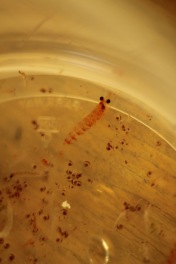So far you have been learning a lot about the chemistry of our oceans and the microscopic critters that live in it. I thought it might be fun to take a step back and think a bit about what these changes may mean for the animals that we like to catch, eat, and observe. What is the impact of ocean change on larger sea creatures (such as fishes, whales, dolphins, and sea birds)? And how does what we are doing on this research cruise matter to them?

In order to think about how ocean chemistry affects fishes or whales, we need to take a step back to Ecology 101. Remember the food web? Food webs describe how the different parts of a system are connected. On land, that includes the plants (or ‘primary producers’) that turn CO2 into edible sugars (like grasses), the little animals that eat those plants (like beavers) and then the larger animals that eat the small ones (like wolves). You can imagine that the more animals you add to the system, the more complicated it can get: if you have elk that eat grass, wolves eat both the elk and the beavers, and if you add bears, those bears might eat both the elk, and sometimes even plant materials (berries! Yum).

Our oceans are just the same. Phytoplankton—from Greek for plant [phyton] and drifter [plankton] are microscopic, free-floating primary producers in the ocean, and they create sugars just like plants do on land. Many different types of critters eat phytoplankton, including little ones called ‘zooplankton’ [yep, you guessed it – Greek for wandering animals]. Zooplankton are a nutritious food source for many larger animals and are a very important link between ocean primary producers and the large animals that we catch, eat, and watch. When we think about what eats zooplankton, like all kinds of fishes, we can start to think about what eats those animals and pretty quickly our ocean food web starts to get quite complicated.
That just about sums up our Ecology 101: food webs are one way that we can think about all the connections in the ocean. They highlight the crucial links between plankton and the animals that might immediately come to mind when we think of sea creatures.

You may now be asking, but why does changing water temperature or chemistry matter to the plankton and fishes (and really to our entire food web)? Let’s think about salmon for a little bit. You may like to eat salmon, or you care about some of the larger marine mammals that love to eat it (like seals and orcas). You may also like to go fishing to catch salmon. Well, one thing that salmon eat are copepods, juicy little zooplankton. It turns out that depending on what temperature the waters are off of Oregon and Washington, different types of copepods are around. In cold water years (such as La Niña years), northern copepods that are lipid-rich—meaning that they are full of nutritious fats—abound. These fatty copepods are a great food source for coho salmon and help them survive the winter. But in warmer years (El Niño), southern copepods that have less fat are most abundant, and salmon have lower survival. (Read more about this relationship here).

Now we know that (a) different types of zooplankton prefer different ocean conditions and (b) that has an impact on their predators (the salmon, which in turn influences other species in the food web), we come back to: how does this connect to the research cruise we are doing now? From Brendan Carter’s post, we know how and why ocean chemistry, in addition to ocean temperature, has been changing through time. Just like the different copepods that prefer different temperatures, we are learning that different types of zooplankton (and many other marine organisms) have different types of reactions to changes in ocean chemistry. Some ocean critters are more capable of tolerating these changing conditions, while others are severely impacted. From lab studies, scientists have learned that a type of Pacific ocean krill, Euphausia pacifica, have developmental impacts during their larval stage from ocean acidification. If this translates to population change (change in the number of krill) there could be dramatic impacts within the food web as krill are an essential food source to many organisms. One thing scientists know is that food webs are changing and will continue to change as a result of ocean acidification and temperature increase, but we are still trying to figure out how, and what our future oceans might look like.
Since many people rely on the oceans for nutrition and a source of employment, the more we learn about current conditions (from this cruise) and compare it to previous ocean chemistry, the better we will be able to predict what the future could look like, and what types of critters will be impacted most. Off the US Pacific coast, where we are now, we have a $475 million dollar per year fishing industry, so the more we can learn about what changes we can expect, the better prepared we might be when those changes occur.
Written by: Emma Hodgson


If,as an Australian study suggests, seagrasses sequester carbon even more than some forests, shouldn’t we do everything we can to protect our shoreline grasses,like eelgrass (both japonica and marina)?
LikeLike
Hi Heather, yes there are many studies demonstrating that seagrasses can bury carbon well. Seagrasses also provide many other ecosystem services by providing habitat, improving water quality, etc. making them one of the many coastal habitats valuable to us!
LikeLike